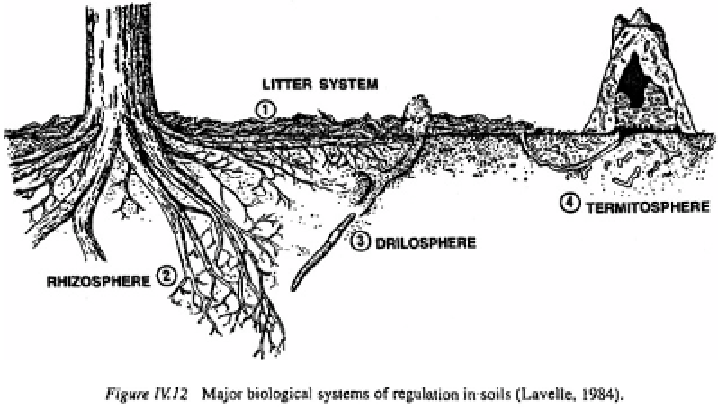Agriculture Reference
In-Depth Information
(i) the
litter system
‚ which comprises leaf litter as a food supply‚ surface lateral roots‚
epigeic invertebrates (mainly arthropods) and microbial communities dominated by fungi;
(ii) the
rhizosphere
‚
i.e.‚
living subterranean roots and the soil and microflora that they
influence;
(iii) the
drilosphere
‚ which include earthworms‚ soil organic matter as a food source‚
and free living soil microflora dominated by bacteria; and
(iv) the
termitosphere
i.e.‚
the whole volume of the soil and organic resources influenced
by termites‚ both directly and through their associations with obligate and facultatively
mutualist micro-organisms. Processes in each of these systems are detailed in Sections
3 to 6 of this chapter‚ respectively.
In the future‚ when their roles are more precisely known‚ it may be possible to define
a 'myrmecosphere'. In a parallel with the termites‚ this could include those ecosystem
components‚ micro-environments and processes affected or mediated directly or indirectly
by ants in those environments where these animals exert a major regulatory influence
on ecosystem processes (see‚ for example‚ Folgarait‚ 1998). Except possibly for the
leaf-cutting ants‚ ants appear to have little direct effect on organic matter decomposition.
However‚ they have strong effects on soil development through void formation and other
processes (Paton
et al.‚
1995) and exert a strong indirect control on the rest of the biota‚
notably on many of the major species involved in soil formation processes.
The
biological systems of regulation
(BSR) have a number of basic properties
in common:
(i) their functioning is largely determined by mutualistic relationships mediated by
highly assimilable compounds (
e.g.‚
root exudates‚ earthworm intestinal mucus) which
may initiate a priming effect on the microflora (see Section I.3.2.5);
(ii) they juxtapose organisms which operate at widely-different scales of time and space
e.g.‚
weeks to months and centimetres for fine roots‚ and hours to days and micrometres
for the associated bacteria;

